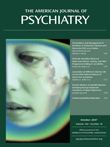This issue of the Journal has two articles on suicidal ideation, defined broadly according to DSM-III-R (recurrent thoughts of death or dying, recurrent suicide ideation without a plan, or a suicide attempt or suicide plan). The two articles study this single symptom of depression from two separate perspectives: as an outcome of life events in a population sample and as a gene association study of emergence of the same symptom in patients being treated for depression.
Keller, Neale, and Kendler, studying individuals in the population-based Mid-Atlantic Twin Registry, looked at persons with dysphoric episodes in the preceding 12 months. These episodes met DSM-III-R symptom criteria for major depression but without the requirement for sadness or anhedonia being one of the symptoms, and with a duration criterion of at least 5 days. From retrospective ratings of both symptoms and life events for the preceding 12 months, the authors found that the symptoms of depression correlated broadly with the life events the subjects associated with their depression, and that this was true even when the same individual had more than one episode during the preceding year. Most interestingly for comparison with the second article, “appetite gain, fatigue, psychomotor retardation, and thoughts of harming oneself were prominent symptoms among those who indicated that nothing caused their episodes, while appetite loss, sadness, and poor concentration were not.”
This might suggest suicidality as a behavioral marker of a less environmentally caused depression and by implication a more genetically caused depression. But that interpretation, not proposed by the investigators, would take the data too far. It would not take into account the problems of retrospectively reported data on two independent variables (clinical diagnosis and life events) that are popularly confounded with each other. Furthermore, there are associations of life events with depression that go back to childhood. Also, suicidality as a surrogate for suicide risk is hardly an established connection. Nonetheless, this is the first study to associate specific depressive symptoms with specific life events in a systematic way, and it will surely be followed by new research with prospective observations.
Laje et al. searched for genetic associations of treatment-emergent suicidal ideation in patients receiving citalopram for major depressive disorder. They tested 768 single nucleotide polymorphisms from various candidate genes and found significant allelic or genotypic association with two markers, which reside within the genes GRIA3 and GRIK2, respectively. Both these genes encode ionotropic glutamate receptors. The biological meaning of these variations remains to be established; they are not part of coding exons of the genes. This study has the methodologic virtues of prospectively collected clinical data and independence of the clinical data from the experimental variables (genotypes). It is very strongly suggestive, and as the authors state, if replicated it would be a major clinical and biological advance if a dangerous clinical event were associated with specific genetic variations.
These two studies, and other recent studies in which life events and individual genotypes were studied in the same individuals at risk for depression
(1), give the field grounds for optimism. The goals that now appear feasible are a comprehensive understanding of genetic and environmental components of depression and related clinical advances in treatment of depression and avoidance of suicidality.

